The ride-hailing industry has revolutionized urban transportation. With a few taps on a smartphone, you can summon a car to whisk you away to your destination. But behind the convenience lies a complex web of labor practices, particularly when it comes to driver compensation. In Minneapolis, Minnesota, this tension between innovation and worker rights came to a head in a battle over minimum wage for rideshare drivers.
A City Pushes for Fairness: The Minneapolis Minimum Wage Ordinance
In 2023, the Minneapolis City Council passed a landmark ordinance aimed at ensuring that rideshare drivers earn a minimum wage equivalent to the city’s standard, which stood at $15.57 per hour at the time. This legislation established a minimum pay structure based on a combination of per-mile, per-minute rates, and a guaranteed minimum per ride. The goal was to provide drivers with a more stable income and improve their working conditions.
The Ridesharing Giants React: Pulling Out of Minneapolis
Uber and Lyft, the dominant players in the ridesharing market, reacted strongly to the ordinance. They argued that the new regulations would make it impossible for them to operate profitably in Minneapolis. They claimed the minimum wage structure would force them to raise ride prices significantly, potentially leading to decreased ridership and ultimately harming both drivers and passengers.
In a move that surprised many, both companies announced they would cease operations in Minneapolis entirely, effective May 1, 2024. This decision left many residents without a convenient and affordable transportation option and raised questions about the future of the ridesharing industry and its treatment of drivers.
The Fallout: A City Without Ridesharing and Drivers Facing Uncertainty
The withdrawal of Uber and Lyft from Minneapolis has had a significant impact on the city. Residents who relied on these services for short trips, commutes, and errands have had to find alternative means of transportation. This has put additional strain on public transportation systems and increased demand for taxi services.
For drivers, the situation is equally uncertain. Some drivers who relied on Uber and Lyft for their primary income are now left searching for new work opportunities. Others may choose to work for alternative ridesharing companies that may emerge in the wake of Uber and Lyft’s departure. However, it remains to be seen whether these companies will be able to offer the same level of service and driver compensation.
The Broader Conversation: Minimum Wage and the Future of Gig Work
The Minneapolis situation highlights the ongoing debate surrounding minimum wage and the rights of gig workers. Gig workers, those employed in short-term, contract-based jobs, often face challenges in securing a stable income and accessing benefits. The ridesharing industry is a prime example of this, with drivers classified as independent contractors rather than employees, limiting their access to traditional worker protections.
The Minneapolis ordinance represents one attempt to address these concerns and provide gig workers with a measure of financial security. However, the withdrawal of Uber and Lyft raises questions about the effectiveness of such regulations. Finding a balance between protecting worker rights and maintaining the viability of these innovative companies remains a challenge.
Looking Ahead: Possible Solutions and the Road Forward
Several potential solutions have emerged in the wake of the Minneapolis situation:
- Negotiating a Compromise: The city council, Uber, and Lyft could revisit the minimum wage ordinance and attempt to find a compromise that ensures fair compensation for drivers while still allowing the companies to operate profitably. This could involve adjustments to the pay structure or exploring alternative funding models.
- State-Level Regulation: Minnesota could consider a statewide minimum wage standard for rideshare drivers to prevent a patchwork of local regulations that could further fragment the industry. This approach could provide more stability and predictability for both companies and drivers.
- National Legislation: The U.S. Congress could explore national legislation addressing the classification of gig workers and their entitlement to minimum wage and benefits. This would create a consistent framework across the country and provide greater clarity for both workers and companies.
The Minneapolis story is a complex one, with no easy answers. However, it serves as a valuable case study in the evolving relationship between technology companies, city governments, and the rights of gig workers. As the ridesharing industry continues to grow, finding solutions that ensure both innovation and fairness will be crucial.
Here are some additional points to consider:
- The impact of this situation on alternative transportation options in Minneapolis, such as taxis and bike-sharing programs.
- The potential for the emergence of new, local ridesharing companies in Minneapolis to fill the void left by Uber and Lyft.
- The broader implications of the Minneapolis situation for other cities considering similar minimum wage regulations for gig workers.
By continuing the conversation and exploring innovative solutions, we can navigate this complex landscape and ensure that the benefits of the ridesharing revolution are shared by all stakeholders.


